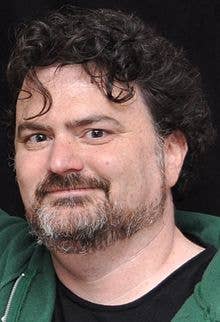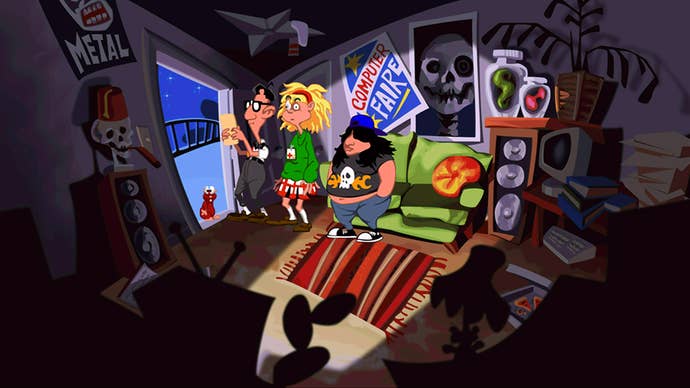Day of the Tentacle: The Oral History
The making of one of the greatest adventure games ever.
This article first appeared on USgamer, a partner publication of VG247. Some content, such as this article, has been migrated to VG247 for posterity after USgamer's closure - but it has not been edited or further vetted by the VG247 team.
Editor's note: What follows is one of three articles about the making of Day of the Tentacle, written in accordance with the release of its Remastered edition. For more about the art of Day of the Tentacle, click here, and for more about the game's music, click here. This article originally ran in 2016.
In retrospect, 1993's Day of the Tentacle can't be seen as anything but the perfect storm of creative minds smashing together.
Where Maniac Mansion and The Secret of Monkey Island set some vital ground rules for adventure games—namely, "don't screw over the player"—Day of the Tentacle took the lessons learned from LucasArts' past seven years and brought the developer's standard of excellence to a whole new level—one that would continue until its legacy came to an end in the early '00s.
Though the "Lucas" name (and bankroll) ensured their games would always have impressive production values, Day of the Tentacle transformed the squat characters of past LucasArts games into huge, expressive sprites, capable of conveying personality and emotion through animation alone. Taking cues from the work of Warner Bros. director Chuck Jones, DoTT sold itself as a "cartoon adventure," and somehow conveyed the bold poses, squash-and-stretch action, and stylized backgrounds of classic animation while trapped under the constraints of a 320 by 200 resolution.

Day of the Tentacle is more than just an artistic achievement, though. Its time-travel premise tasks players with exploring three different versions of the titular Maniac Mansion—past, present, and future—using straightforward cause-and-effect logic to make its puzzles more reasonable (not to mention ingenious). All these qualities, combined with DoTT's memorable and unique cast of characters, make this unassuming little sequel one of the greatest adventure games of all time—so it's more than a little tragic that we're only seeing an official re-release some 23 years later.
To celebrate Double Fine's new Remastered version, I recently sat down with nearly every key staff member from Day of the Tentacle to talk about their memories, as well as their contributions to the new release. This portion of the oral history features commentary from Day of the Tentacle directors Tim Schafer and Dave Grossman, as well as Remastered producer Matt Hansen. Read on, and be sure to check out the other portions of this retrospective for everything you've ever wanted to know about Day of the Tentacle.

Origins
After the release of 1991's Monkey Island 2, LeChuck's revenge, designers Tim Schafer and Dave Grossman found themselves in the position of project leaders following the departure of Ron Gilbert. The only question left for them: "What, exactly, do we do now?"
Tim Schafer: Ron [Gilbert], who was our project manager on Monkey Island, he thought we were ready to be project leaders, and he told management, “I think Tim and Dave should be project leaders.” And, they were like, “What should we have them do?” And, Dave and I—I think we were too scared to actually come up with something new at the time. And they were like, “You want to do a sequel to Maniac Mansion?” We were like, “Yes, yes.” That was as big relief, that we didn't have to come up with a whole new game our first time out.
Dave Grossman: There were some ideas already floating around, and Ron had said he had always wanted to do a time travel game. I think there were a few other proposals, actually, besides that. I wouldn't swear to it, because I remember settling on the time travel thing pretty quickly. We all liked that a lot.
TS: Ron was actually around for the beginning of the design process, and then he left to start Humongous [Entertainment], and Dave and I were on our own to really run with it. [We] brought on Larry Ahern and Peter Chan to do the art, and that's when we really gelled as a team and took off. But yeah, the whole idea of time travel was Ron's.

DG: There wasn't any detail beyond that. There was no, "Let's go to this time period or that time period." That was something that the four of us all sat down and worked out together. So, it was Tim and I, [and] Ron and Gary [Winnick] all sitting in a room. The way we did that was mostly to think about different time periods and what would be the kinds of things that we would be able to do there, who we might meet and talk to, and to some degree, some puzzles that might work. But we didn't really think about it too much at that stage. And, a few prospects had a lot of meat to them, and some others didn't. "Oh, this Revolutionary War period has a lot of stuff that sings for all of us," and so we wanted to include that one. And we felt like, the future, we got to do that, so, there's nothing specific about it, but it allows us to philosophize about some cause and effect and societies and stuff like that. So, that seemed cool.
TS: We actually had six characters in the original [concept], and, our original intention was to use all of them. Well, you know, the original Maniac had six or seven, so, we were going to let you pick three from that in the same way that that game did. When we started calculating the workload of making the game before we even designed the first room of it, that immediately seemed like it was just going to balloon things well out of proportion for what we would actually do, because now we were having to support a lot more specific animations and stuff.
DG: Bernard—we just felt very enamored of him, always, from day one. He was everybody's favorite character from the first game, so he was kind of a given. So, he was kind of the nerdy one, so having the cool dumb one and the crazy one, that felt like a good counterpoint to us. And then, the other characters, I remember, there was Moonglow, who was this hippie girl who ended up on the cutting room floor. There was Chester, who was this tall skinny artist who wound up being remade into Ned and Jed Edison. So, we just took the character design for him and used him for them instead, saved ourselves a little extra work.
TS: We found a document that has the six kids, and it was, Bernard, Hoagie, Laverne, Chester, Moonglow, and Razor. So we picked the two that were our favorites, Razor and Bernard, and then added these four. And then, at our first pitch meeting, everyone's like, "There's too many characters in this game. You're never going to get it done on time. Cut half the characters." And so I cut it down to three.
